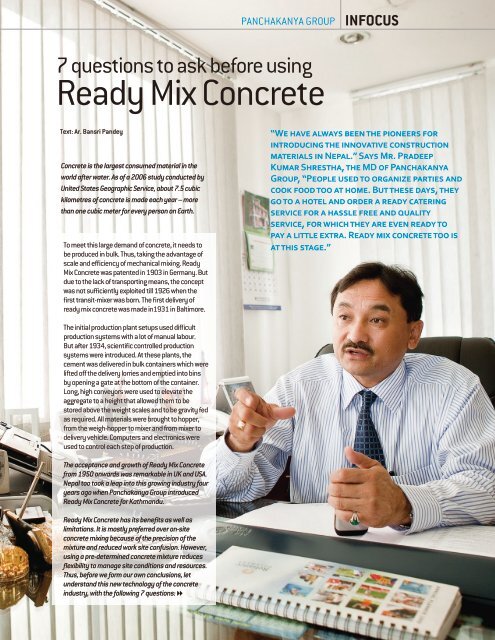6. Nov-Dec 2010
You also want an ePaper? Increase the reach of your titles
YUMPU automatically turns print PDFs into web optimized ePapers that Google loves.
PANCHAKANYA GROUP<br />
INFOCUS<br />
7 questions to ask before using<br />
Ready Mix Concrete<br />
Text: Ar. Bansri Pandey<br />
Concrete is the largest consumed material in the<br />
world after water. As of a 2006 study conducted by<br />
United States Geographic Service, about 7.5 cubic<br />
kilometres of concrete is made each year – more<br />
than one cubic meter for every person on Earth.<br />
To meet this large demand of concrete, it needs to<br />
be produced in bulk. Thus, taking the advantage of<br />
scale and efficiency of mechanical mixing. Ready<br />
Mix Concrete was patented in 1903 in Germany. But<br />
due to the lack of transporting means, the concept<br />
was not sufficiently exploited till 1926 when the<br />
first transit-mixer was born. The first delivery of<br />
ready mix concrete was made in1931 in Baltimore.<br />
“We have always been the pioneers for<br />
introducing the innovative construction<br />
materials in Nepal.” Says Mr. Pradeep<br />
Kumar Shrestha, the MD of Panchakanya<br />
Group, “People used to organize parties and<br />
cook food too at home. But these days, they<br />
go to a hotel and order a ready catering<br />
service for a hassle free and quality<br />
service, for which they are even ready to<br />
pay a little extra. Ready mix concrete too is<br />
at this stage.”<br />
The initial production plant setups used difficult<br />
production systems with a lot of manual labour.<br />
But after 1934, scientific controlled production<br />
systems were introduced. At these plants, the<br />
cement was delivered in bulk containers which were<br />
lifted off the delivery lorries and emptied into bins<br />
by opening a gate at the bottom of the container.<br />
Long, high conveyors were used to elevate the<br />
aggregate to a height that allowed them to be<br />
stored above the weight scales and to be gravity fed<br />
as required. All materials were brought to hopper,<br />
from the weigh-hopper to mixer and from mixer to<br />
delivery vehicle. Computers and electronics were<br />
used to control each step of production.<br />
The acceptance and growth of Ready Mix Concrete<br />
from 1950 onwards was remarkable in UK and USA.<br />
Nepal too took a leap into this growing industry four<br />
years ago when Panchakanya Group introduced<br />
Ready Mix Concrete for Kathmandu.<br />
Ready Mix Concrete has its benefits as well as<br />
limitations. It is mostly preferred over on-site<br />
concrete mixing because of the precision of the<br />
mixture and reduced work site confusion. However,<br />
using a pre-determined concrete mixture reduces<br />
flexibility to manage site conditions and resources.<br />
Thus, before we form our own conclusions, let<br />
understand this new technology of the concrete<br />
industry, with the following 7 questions:8<br />
<strong>Nov</strong>ember-<strong>Dec</strong>ember <strong>2010</strong><br />
29<br />
www.spacesnepal.com

















